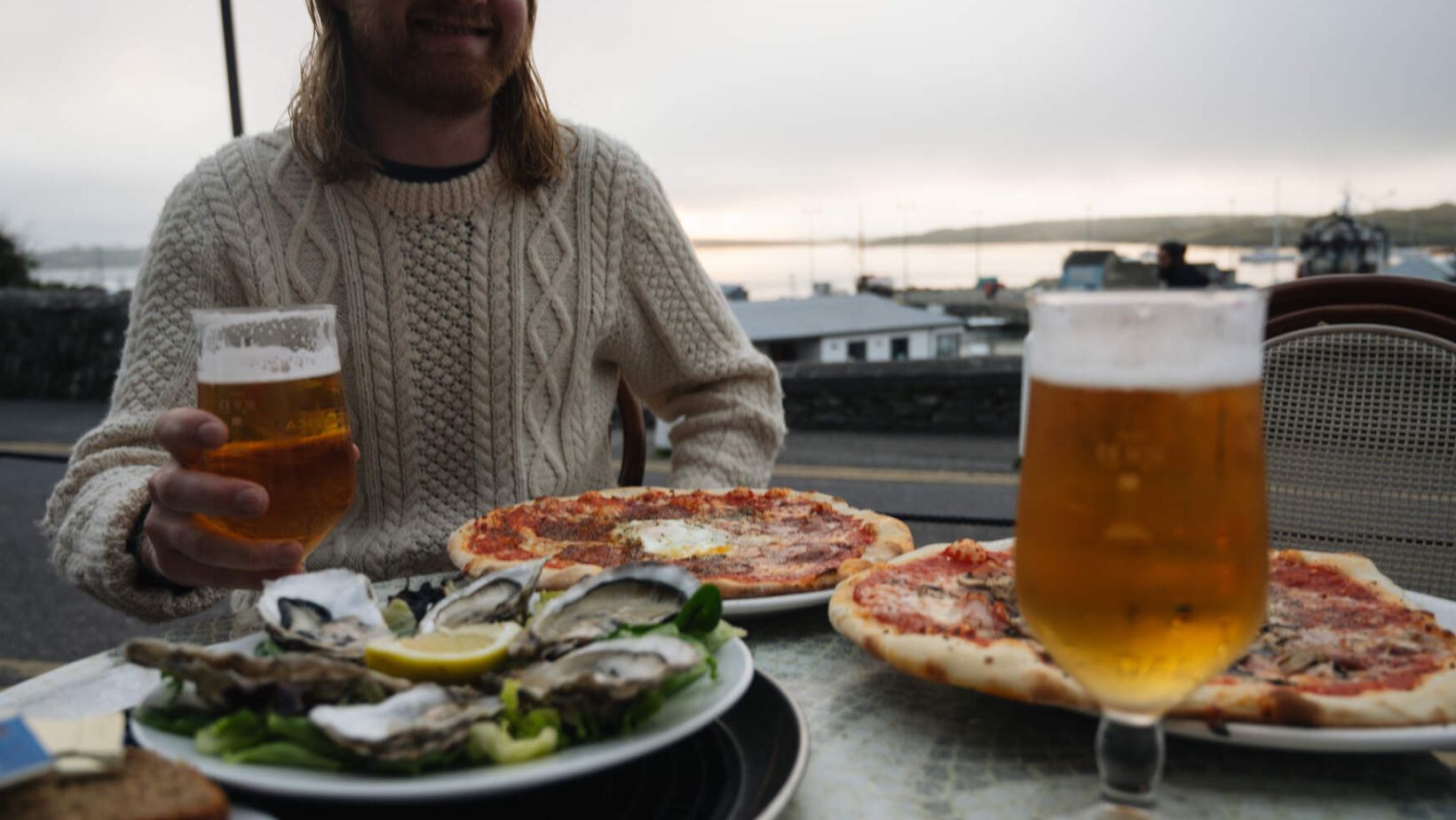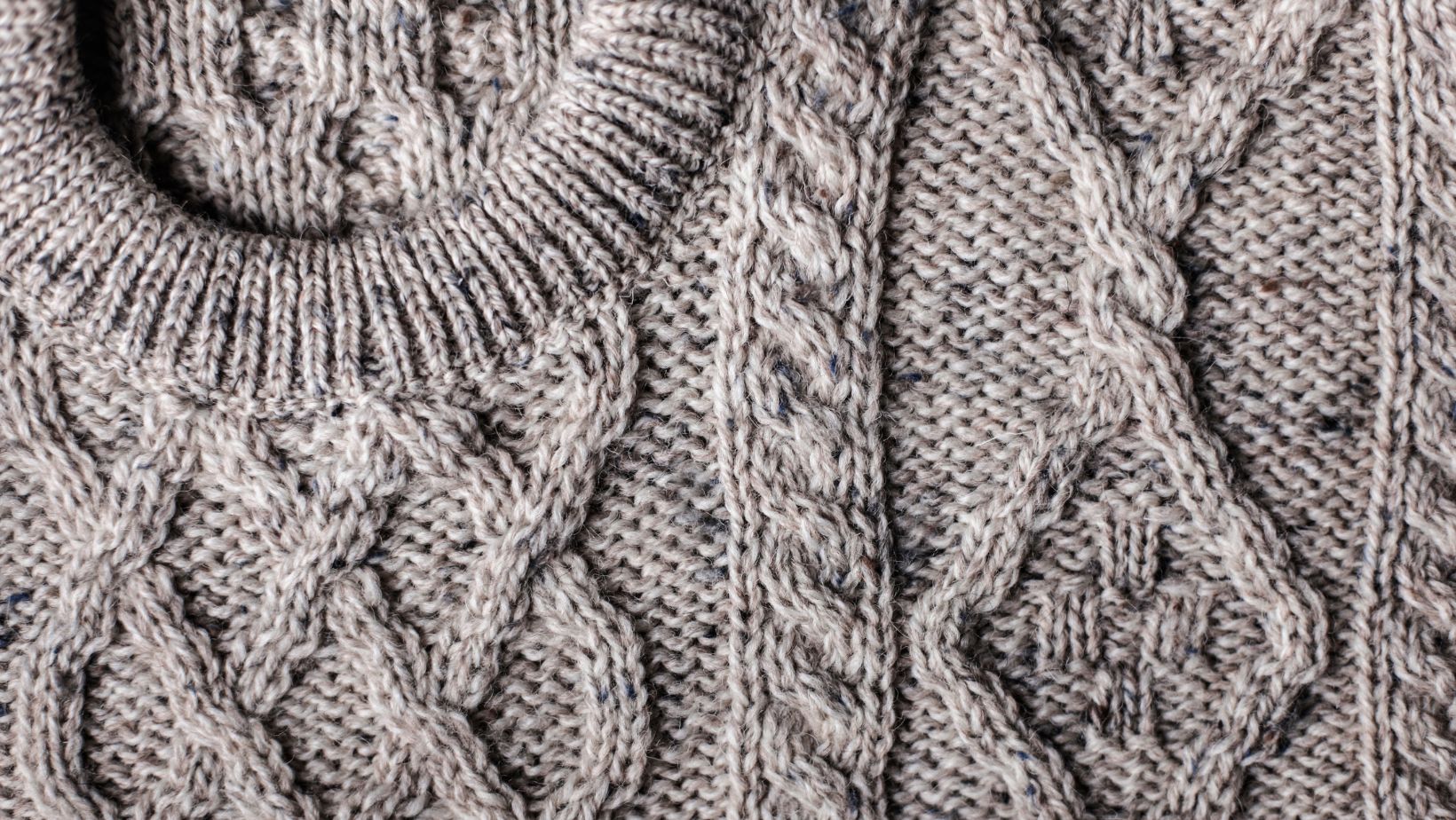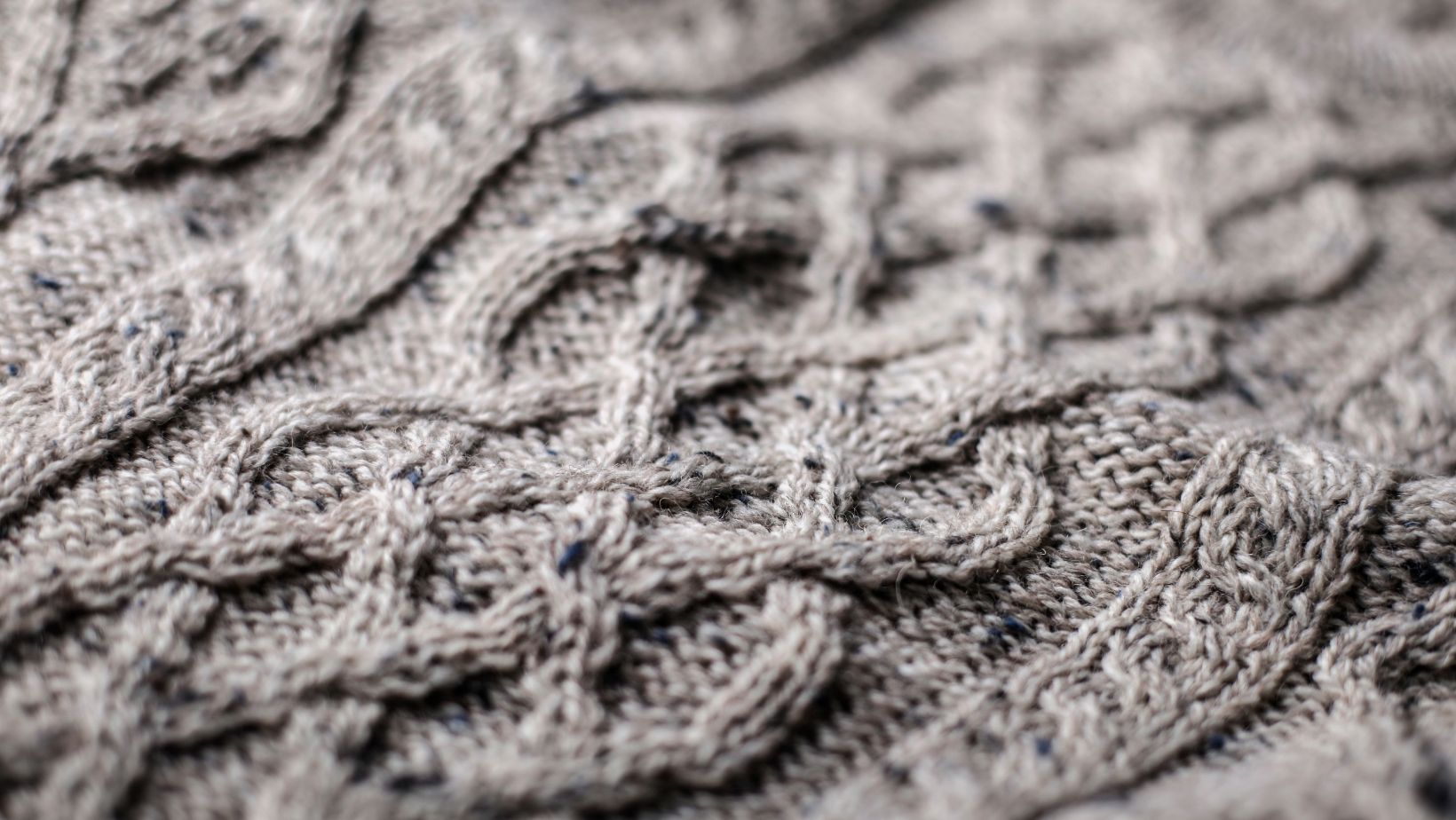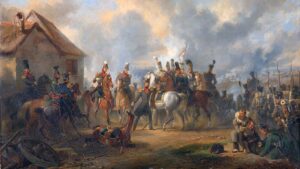Ireland is a beautiful place, alive with the magic of legends and folklore, and the Aran Islands are an especially magical part of the Emerald Isle. The landscapes we see along Ireland’s wild Atlantic coastline are the perfect backdrop for fairy stories and tales of old, and the people who inhabit these areas today still share the cultural heritage of their ancestors.
Imagine living on Inis Mor, the largest of the Aran Islands, hundreds of years ago when there was little protection from the elements and no heating or electricity to make life easier. Those who lived on the Aran Islands were usually fishermen or farmers, and their families would have handed down the skills they needed to survive. One of these skills was making clothing, which would keep them warm and dry while working, and weaving was a traditional skill that was highly valued at this time. The Aran wool sweater was born from this background, and it still maintains the connection with its roots today.
Table of Contents
ToggleThe Legends of the Aran Sweater
Aran sweaters are arguably the most famous export from the Aran Islands, synonymous with the legends and magic of this wild place. The stitches that decorate Aran sweaters are full of meaning that relates to the weavers and their families when they were first woven many years ago. Today, the Aran Irish Sweater is a fashion statement that can be given a modern twist to become a wardrobe staple for everyone, but it is still an important part of Ireland’s heritage, and this is woven into every thread.
Aran sweaters were believed to have been first worn by the fishermen and farmers of the Aran Islands, who made their livelihoods in the harsh climate on the Atlantic coast. The sweaters were designed to keep them warm and protect them against the elements, and they were decorated with stitches that represented their way of life. This makes them a piece of living history, and when these stitches are used today, it connects us with the past and celebrates the way these communities lived in harmony with the land and the sea.
The Stitches That Tell Stories
The stitches used in Aran sweaters were personal to the families that wore them, and it is often said that women would knit specific stitches to bring good luck and keep their loved ones safe, especially at sea. The thick layers of stitching have a practical purpose, keeping the wearer warmer, and they also tell stories that are fascinating to discover. See if you can see the following stitches in our designs:
- Cable stitch. A cable stitch is a technique whereby the stitches are crossed over one another to create a pattern of twisted cables, with one cable being held on a cable needle while others are worked. It is a complex knitting stitch that is easy to spot, and it can be used to create a variety of beautiful designs. It is often combined with other stitches in our sweaters and blankets and has been incorporated into many other stitches with impressive craftsmanship. It is the most commonly used stitch in Aran sweaters today and is believed to represent the ropes of fishermen and bring them good luck while they are at sea, as well as bringing them safely home again. We love the modern twist that the Wool Cashmere Cable V-Neck Sweater brings to the traditional cable stitching technique. It’s a gorgeous v-neck with delicate cable stitching, and the cashmere blend makes it easy to wear, even if you have sensitive skin.
- Honeycomb stitch. The honeycomb stitch is included in many beautiful Aran sweater designs and is believed to bring good luck to the wearer as it signifies prosperity. It’s created to look like a honeycomb, paying tribute to the honey bees and their hard work. The classic Merino Aran Sweater features honeycomb stitch as well as cable stitch and is a popular choice for many of our customers from all over the world. It is available in a range of beautiful colors, including the traditional white and oatmeal options, and when yours arrives, you will soon see why it is so well-loved.
- Moss stitch. Many of the stitches used to weave Aran sweaters are thought to have been inspired by the landscape of the Aran Islands, and the carrageenan moss that proliferates on the Islands is believed to be the inspiration for the moss stitch. This sea moss, also known as Irish moss, has been used for centuries as a health tonic to soothe sore throats and treat persistent coughs. It was a food source for the people of the Aran Islands for many years, contains many vitamins, and is a good source of protein at rare times.
- Zig zag stitch. Zig zag stitch is thought to represent the ups and downs of married life and is often incorporated into blankets and items of clothing given to newlyweds to celebrate their nuptials. It is also evocative of the winding cliff paths that the fishermen of the Aran Islands and their families would have traveled up and down to the sea and home again on a daily basis.
- Blackberry stitch. Blackberries are a great food source that grow all over the Aran Islands and they are represented in this detailed stitch. This is a tactile stitch that feels as good as it looks, and it can conjure images of searching for food in nature and then creating fabulous blackberry pies while looking out over the Atlantic.
- Tree of Life stitch. Trinity stitch, or the Tree of Life stitch, is believed to represent the unity of families and bring luck to the wearers and to their children. This stitch is created by knitting and purling stitches in a tendril pattern, evocative of the Celtic symbols that date from around 500 BC, when it is thought that the Celts first arrived in Ireland.
- Trellis stitch. Trellis stitch is thought to represent farming on the Aran Islands, with small squares that are inspired by the field patterns of traditional Irish farms. Fields were marked with stone borders, and this was picked up in the stitching. You can see this in the Wool Cashmere Aran Trellis Sweater, which is a contemporary design that evokes the past with this delicate stitching.
Our range of Aran sweaters includes heritage garments and designs that represent different clans and their lifestyles, and we love the way that traditional craftsmanship and legend come together to create these unique pieces.
Visiting the Aran Islands
If you get the chance to visit the Aran Islands, we strongly advise you to take the plunge! This beautiful part of the world is a maelstrom of wild oceans and green landscapes, and it’s a real gem to visit. Making the most of the local area on a bike is a popular choice, and we love to hear about the experiences of those who have traveled around the islands.
The three Aran Islands are located across the mouth of Galway Bay, and include Inis Mor, the ‘Great Island’, Inis Mean, the middle island and Inis Oir, the small island. The islands have been inhabited since the late Neolithic period, with monuments dating from around 2,500 BC, and the earliest settlers are believed to have arrived from mainland Ireland in curraghs, small boats covered with animal skin. If you are lucky enough to spend time in the Aran Islands, you should be sure to visit:
- The Wormhole. The Wormhole, or “Poll na bPeist,” is a natural blowhole on Inis More, located near the village of Gort Na gCapall. Legend tells us that the wormhole is all that remains of a tunnel dug by a giant from one side of the island to the other. You will need to follow signs from the village, walking along the coast for approximately 20 minutes. There are plenty of signs to follow, and if you visit in the summer months, you’ll see impressive ocean views as well as this spectacular natural phenomenon. However, if you can visit in the winter, you’ll be able to witness the incredible power of nature as the waves are likely to be more dramatic. This is well worth a visit, but it is important to be aware of your safety, especially at this time of the year.
- Dun Aonghus. Dun Aonghus is a fort that dates from the Bronze Age and folklore suggests that it was the home of the Fir Bolg tribes, led by Aonghus, after being defeated in the First Battle of Moytura. This impressive site is an evocative place, with the original stone fort having been expanded in Medieval times. Some parts of the great wall were six meters wide and five meters high, making it an impressive home and the ideal place from which to guard the entrance to Galway Bay.
- Kilmurvey Beach. Kilmurvey is a Blue Flag beach in the village of the same name, and the clear waters and beautiful white sand make this a very popular place to visit when you’re on the Aran Islands. The sheltered cove is close to the shops and cafes in the local village, and the beach is lifeguarded during the summer months, so you can enjoy a swim without compromising on safety. This is a perfect spot for families and swimmers, and there are also ideal opportunities for fishing and walking around the cove.
- Inis Mor Seal Colony. If you’ve never seen seals in the wild, you’re in for a treat – and even if you have, this is a wonderful spectacle! The seal colony on Inis More is located along the coast from Kilmurvey Beach, and you can follow signs and enjoy a picnic if you want to make the most of your visit. Check the tide times before you make the trip, as you are likely to enjoy much better views if you visit at low tide when the seals are more likely to be visible on the rocks.
- Straw Island. Straw Island is a very small island with a lighthouse, which has been uninhabited for many years. It is home to a huge population of grey seals, and diving and snorkeling trips can take place here. You can find trip operators in the village of Kilronan and enjoy observing the seals in their own habitat, which may be especially impressive in the spring.
- Clochan na Carraige. Clochan na Carraige is another popular attraction on Inis Mor, a stone beehive hut that is believed to date from early Christian times. It was used as a dwelling and an animal area and is thought to be one of the best examples of a stone beehive hut in Ireland. It is an oval-shaped building that is rectangular inside with doorways to the northwest and southwest. It has a cobbled roof that would originally have been covered in soil and grass. This is a great opportunity to step into the past and appreciate what life might really have been like for Island dwellers all those years ago.
Your visit to the Aran Islands will show you the magic of this wonderful place, and you will see why the Aran sweater has such a unique and beautiful connection to it.
Find Your Aran Sweater at Aran Sweater Market
Here at the Aran Sweater Market, we work with the finest craftspeople in Ireland to bring you unique and beautiful items that represent the best of Irish heritage. The Irish folklore and tradition woven into every Aran sweater make it possible for you to own a piece of Irish history for yourself and gives you an insight into the lives of the people who first inhabited this wild and challenging place.
We have several stores in Ireland, such as Killarney, Kenmare, Dublin, Galway, Glengarriff, and Kinsale, as well as our online catalog at Aran Sweater Market. Our friendly team will help you to find exactly what you are looking for, from handwoven garments to artisan gifts that will become heirloom pieces in your family history. Visit us to find out more about our ethos and the heritage crafts we support.







